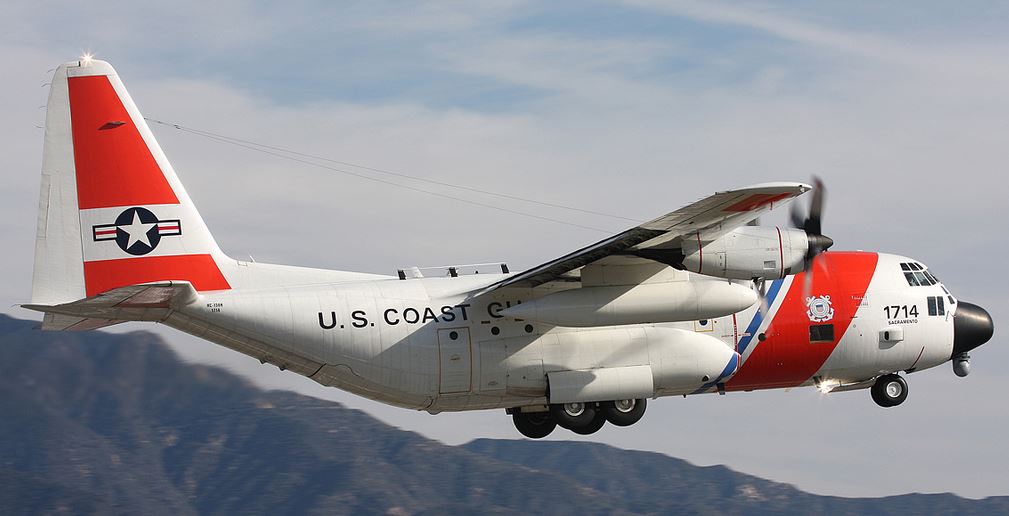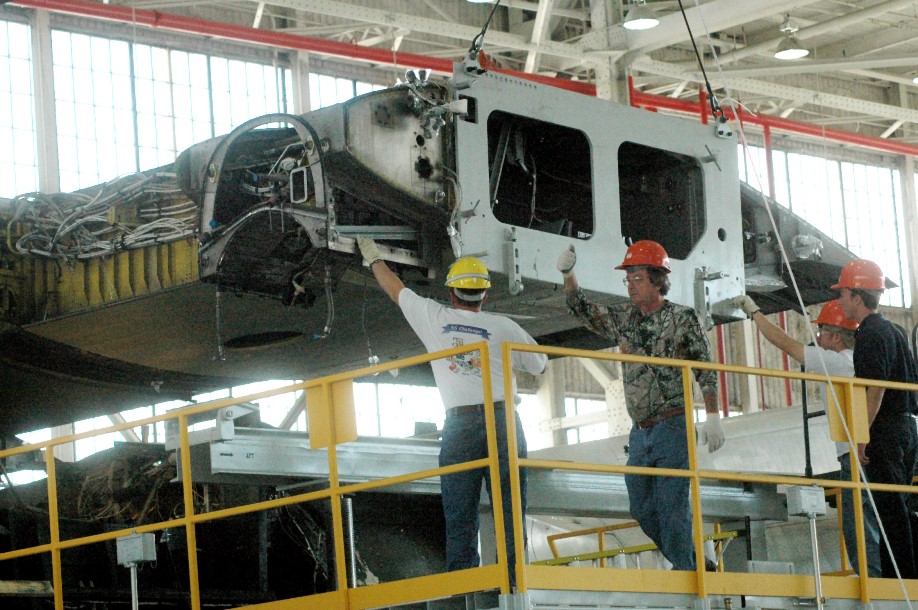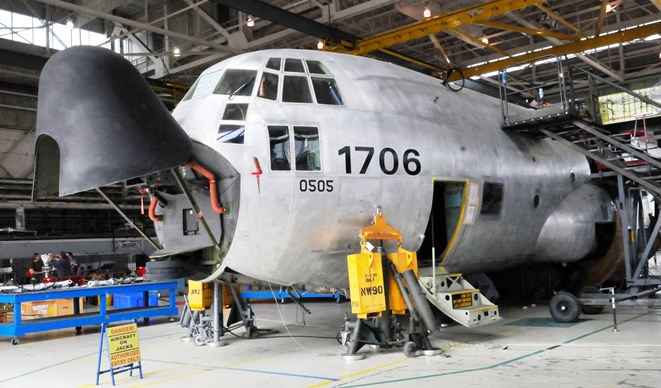
The legislation that enabled the transfer of seven C-130H aircraft from the Coast Guard to the U.S. Forest Service to serve as air tankers required that the wing boxes be replaced and other maintenance be performed.
 A wing box is the core or backbone of an aircraft. In a C-130 it sits atop the fuselage and forms the attachment point for both wings. A failure of the wing box during flight could be catastrophic.
A wing box is the core or backbone of an aircraft. In a C-130 it sits atop the fuselage and forms the attachment point for both wings. A failure of the wing box during flight could be catastrophic.
In the mid-2000s, center wing boxes (CWB) on C-130s began showing cracks earlier than expected. Many of the aircraft were grounded or placed on restricted flight status, including some that were flying in Iraq and Afghanistan. In 2006 the Air Force began a program to replace them on all C-130 models except the C-130J which entered the inventory in February, 1999. By 2020, 155 C-130s will have new CWBs that are the same ones being manufactured today for the C-130J.

The total cost of a CWB kit in 2011 was $6.7 million, including installation which takes about 10 months.

A couple of years ago the Coast Guard identified six C-130Hs to undergo CWB replacements. The first, #1706 seen in the photo above, was completed August 12, 2012. A second C-130 began the process in November, 2012 and should have been complete by September, 2013. The other six aircraft numbers that are being transferred to the USFS are 1708, 1709, 1713, 1714, 1719, and 1721. Many of the CWB replacements for the Air Force and Coast Guard aircraft are being done at Robins Air Force Base in Georgia.
The Coast Guard expected that the CWB and other upgrades would allow the C-130Hs to serve until 2027, after which they would be replaced by new aircraft. They have already started ordering C-130Js, tagging on to Air Force procurement programs..
Wildfire Today has found information which indicates the seven C-130s being given away by the Coast Guard were manufactured between 1983 and 1987, but this is not yet confirmed. If the data is accurate, they are 27 to 31 years old now, and will be 40 to 44 years old in 2017. A person might wonder why the Coast Guard can buy new C-130Js while the U.S. Forest Service has to make do with hand-me-down aircraft being discarded by another agency.

In addition to replacing the CWBs, the legislation requires “progressive fuselage structural inspections” for the seven Coast Guard C-130s being transferred to the USFS. If they receive the standard primary structure inspection — known as programmed depot maintenance — that process will take between 180 and 200 days. In February, 2013, the Ogden Air Logistic Complex at Hill Air Force Base in Utah began performing some of the programmed depot maintenance on the Coast Guard C-130s, aircraft which are similar to the C-130s flown by the Air Force, but they have more avionics for radios and radar.
The legislation directed that no more than $130 million be spent by the Department of Defense to modify and maintain the seven C-130s before the transfer; any additional funds would have to come from the USFS. Doing a little math here, if the CWB replacement costs $7 million each, the programmed depot maintenance runs $3 million per aircraft (to pick a number out of the air), and the installation of the retardant tank system is $4 million (Coulson’s preliminary estimate is $3.5 million each for their Aero Union/Coulson RADS tank), we are looking at a total of about $98 million — within the $130 maximum allowed by Congress. If $14 million is subtracted for CWB replacements that have already occurred on two aircraft, that total is brought down to $84 million.
However, there will no doubt be other work that will have to be done to the aircraft, such as installation of radios, a real time location tracking system, and perhaps other avionics and a stress monitoring system. It is also possible that unneeded equipment such as a cargo handling system and armor will have to be removed, all of which could require more USFS dollars unless these items are included in the total conversion project funded by the military, rather than done later by the USFS. These additional tasks would push the price closer to the $130 million threshold.

How does the USCG get their hands on C130J’s when the USFS gets hand me downs?
I am SURE it is similar to the DoD and their already programmed acquisitions costs and figured every year based on BUDGETS
Something the USFS needs to LEARN when it comes to these types of capital costs..
How about telling the USFS that there is a 178 page manual called Major Systems Acquisition Manual put out by the USCG.
You would think with all the “best and brightest” with 4.0 GPA’s housed out there in the Beltway….this manual and many manuals like it would have been their first choice in how to acquire, finance, maintain , and sustain a program such as the LAT program
But….the USFS has made this a rocket science program because they just could not see all the information that industry, DoD, DHS, NOAA, and NASA have done their aircraft acquisition programs.
The information has been out there for YEEEEEEAAARS…..the USFS just choose to reinvent the wheel to call it their own. With their 100+ year old ways of thinking, reinvention of the wheel seems just possible.
But to say none of this information is out there with sources I have mentioned….that is a complete falsehood and the USFS aviation should be pressed by industry AND the Congress and be grilled for a complete lack of planning and just because someone is doing CWB ‘cuz of political pressures and having to to use USAF resources shows that the agency is not well suited for a 7 LAT aircraft program because what they have showed in the contracting world shows that they have no real world air transport experience in and above the Smokejumper program and just because one owns 7 C130 H models in their livery, does not make them an expert just because of managing a MAFFS program……
Managing is different than actually owning and signing the aircraft off every day for flight and safety of flight.
Just because the USFS has this SMS safety program, does not make them a subject matter expert on ownership of large category transport aircraft by any means!!
Maybe the USFS can ask NOAA or NASA how they manage their aircraft. They have operated with contract maintenance for some time.
Easy answer on the 30 yr cycle, Johnny…..
Retirements and the never ending inability to hand it down to educated successors.
Airtanker studies are easier on a every 5 years cycle….
Easier that way just to push it around to the 30 yr cycle and not have any actionable responsibilty later!!
Why does the Feds go through this cycle every thirty years? It all about politics, look what where doing for the people! As in the past the private sector is doing a great job of providing “new” and innovative air tankers. This week Aero Air starts cup/grid testing when the Santa Anna’s stop blowing and the smoke clears, very exciting. Aero-Flite’s Bae 146; someone said it reminds them of an F7F air tanker with jet engines. Let’s don’t get distracted, let the private companies provide the air tankers and focus on 35 (seven day coverage) air tankers. Return to an Federal INITIAL ATTACK policy that gives the fire fighter on the ground a chance.
Johnny that is it-INITIAL ATTACK! (though I have said the best initial attack tanker was a DC-4/6/7 but I have my prejudices…)
Good deal..
I suppose and hope that USFS is inspired by Calfire’s model and that they’ll create an aviation management unit which will oversee the contracts (maintenance and crews).
let’s hope these Hercs will be 1) tanked properly with constant flow RADS (ref: Coulson’s)
and 2) operated efficiently :
dispatched for Initial attack to fight fires… to win the fight as many times as possible.
Good to see that two C-130s have already gone through the upgrades.
Next step is advertising and awarding a contract for tanking the aircraft…. followed by advertising and awarding a contract for “government owned, contractor operated” start-up.
Heck… we can’t even hire employees in less than 120 days anymore… the likelihood of getting through contracting this fire season is pretty much nil…. unless there is a huge paradigm shift.
Ok….
Well all this could get set back if there is a priority setup
for the military. Say the Norks going south,etc.
Anything in between. I do not have a good feeling about
this. Thanks,Bill..
You know, after all of this depot level maintenance gets done, you have to wonder will the Forest Service put out a solicitation for bid, the maintenance, operation and crewing of these aircraft. Would they let the current operators bid on possibility of running these aircraft for the Forest Service or will they let DynCorp,L3 or some other big government contractor be the only ones allowed to bid the contract. But another thing is if they do go the contract route and let anyone bid on it, and after the supposed contract award how long do you think it will take for the aircraft to actually get online barring any contract award protest’s?
I do not think personally that we will seen one of these birds online and ready to fight fire before the middle of the 2015 season. That opinion is based on the current track record of the Forest Service contract awards and contract disputes being settled. Another to consider is are they just going to call up Coulson and order seven complete tank systems or are they going to put out solicitation for bids on that as well? There are still too many what if’s in this whole program.
Good work, Bill
Now the folks will understand the 10 months and the complexity of the CWB process and the beliefs that the LMA’ s thinking they are going to see a ‘130 THIS year.
That belief was never held by any of us in the real aviation world…..thinking this was going to happen, to see 1 or 2 aircraft this year was a hope with others than the aviation world.
Keep this up, Bill. This stuff needs to be put out to show the general public who have snowed by politicos and USFS leadership each year that they both have promised that we got this “handled” every year. This will prove to all LMA.’s and even the NASF that without money and spending someone else ‘s money…… The taxpayer and the USAF dinero……that all the LMA’s and State Foresters had better plan on an aviation slush fund and hire professionals into the LMA world……more than they have in the last 20 yrs….
Because this article, in my mind, illustrates just fraction what goes on in industry, with DoD money and contract operators who have invested their own money to get a contract to “protect the resource!”